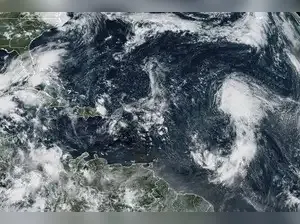The Southwest faces a renewed flash flooding risk beginning Sunday, September 21, as tropical moisture returns to the region following several days of deadly flooding. Meanwhile, Tropical Storm Gabrielle continues developing in the Atlantic Ocean.
Scattered showers and thunderstorms are possible Saturday, primarily north of areas recently affected by flash flooding. No organized flash flooding threat exists today as tropical moisture diminishes across the region. Currently, no flood alerts remain in effect.
A new burst of monsoonal moisture will create a Level 1 of 4 flash flooding risk for portions of the Desert Southwest Sunday through Monday. Isolated downpours and thunderstorms could produce localized flash flooding across far southern California and Arizona on Sunday. The low flood threat shifts eastward into parts of New Mexico on Monday.
Also read: Tropical storm Gabrielle expected to strengthen into a hurricane this weekend as it moves across the Atlan
Burn scar areas face heightened flash flooding dangers that could trigger debris flows and mudslides. Burned soil reduces the rainfall threshold needed for flash flooding, meaning lower precipitation totals can generate significant flooding impacts that develop rapidly.
Dry and quiet weather conditions are forecast for most of the Southwest through the remainder of next week.
The City of Barstow announced Friday that "After more than 20 hours of extensive search and rescue operations, emergency responders located the child's body."
Flash flooding occurred throughout other Southwest areas as the heaviest downpours delivered 1 to 2 inches of rainfall within approximately one hour in some locations. The intense precipitation washed out roads and swept away objects in the path of rushing floodwaters.
Gabrielle is expected to enter an area with reduced wind shear and dry air, along with warmer water temperatures, likely allowing it to strengthen into a hurricane by late Sunday. The system will not produce direct land impacts as it remains east of Bermuda early next week and eventually turns northeast across the north-central Atlantic by midweek.
Also read: Tropical Storm Gabrielle path avoids major US cities as system strengthens in Atlantic
If Gabrielle reaches hurricane status, it would become the second hurricane of the 2025 Atlantic hurricane season. Typically, the season's second hurricane forms around August 26, making this potential hurricane nearly one month behind the average timeline.
Hurricane hunter aircraft are scheduled to investigate Gabrielle to better assess the storm's current structure and intensity.
Should this system develop further, it would likely follow a similar path to Gabrielle, avoiding direct land impacts.
Atlantic tropical activity is forecast to gradually increase over the coming weeks as atmospheric conditions become more conducive to storm development.
The Atlantic hurricane season continues through November 30.
Also read: Tropical wave off Africa may strengthen into Storm Gabrielle; NHC warns of rising Atlantic hurricane threa
Residents in flash flood-prone areas should monitor weather conditions closely and avoid attempting to cross flooded roadways or waterways during heavy rainfall events.
Scattered showers and thunderstorms are possible Saturday, primarily north of areas recently affected by flash flooding. No organized flash flooding threat exists today as tropical moisture diminishes across the region. Currently, no flood alerts remain in effect.
A new burst of monsoonal moisture will create a Level 1 of 4 flash flooding risk for portions of the Desert Southwest Sunday through Monday. Isolated downpours and thunderstorms could produce localized flash flooding across far southern California and Arizona on Sunday. The low flood threat shifts eastward into parts of New Mexico on Monday.
Also read: Tropical storm Gabrielle expected to strengthen into a hurricane this weekend as it moves across the Atlan
Burn scar areas face heightened flash flooding dangers that could trigger debris flows and mudslides. Burned soil reduces the rainfall threshold needed for flash flooding, meaning lower precipitation totals can generate significant flooding impacts that develop rapidly.
Dry and quiet weather conditions are forecast for most of the Southwest through the remainder of next week.
Recent Southwest flooding causes fatality
Heavy rainfall and flash flooding affected the Southwest over recent days, resulting in one fatality. In Barstow, California, a 2-year-old child was swept away after floodwaters overtook the family's vehicle and carried it off a roadway.The City of Barstow announced Friday that "After more than 20 hours of extensive search and rescue operations, emergency responders located the child's body."
Flash flooding occurred throughout other Southwest areas as the heaviest downpours delivered 1 to 2 inches of rainfall within approximately one hour in some locations. The intense precipitation washed out roads and swept away objects in the path of rushing floodwaters.
Tropical Storm Gabrielle strengthens in central Atlantic
Tropical Storm Gabrielle continues moving through the central Atlantic while combating unfavorable atmospheric conditions. The storm is slowly improving structurally as of late Saturday morning but continues encountering wind shear and dry air, conditions that challenge tropical cyclone survival.Gabrielle is expected to enter an area with reduced wind shear and dry air, along with warmer water temperatures, likely allowing it to strengthen into a hurricane by late Sunday. The system will not produce direct land impacts as it remains east of Bermuda early next week and eventually turns northeast across the north-central Atlantic by midweek.
Also read: Tropical Storm Gabrielle path avoids major US cities as system strengthens in Atlantic
If Gabrielle reaches hurricane status, it would become the second hurricane of the 2025 Atlantic hurricane season. Typically, the season's second hurricane forms around August 26, making this potential hurricane nearly one month behind the average timeline.
Hurricane hunter aircraft are scheduled to investigate Gabrielle to better assess the storm's current structure and intensity.
Additional Atlantic tropical activity monitored
The National Hurricane Center is monitoring a weak tropical wave positioned off Africa's west coast that is generating disorganized thunderstorm activity. The system has a 20 per cent development probability over the next seven days as it slowly moves across the central Atlantic.Should this system develop further, it would likely follow a similar path to Gabrielle, avoiding direct land impacts.
Atlantic tropical activity is forecast to gradually increase over the coming weeks as atmospheric conditions become more conducive to storm development.
The Atlantic hurricane season continues through November 30.
Flash flooding safety considerations
Areas with burn scars from recent wildfires face particularly dangerous flash flooding conditions. The altered soil composition in these regions significantly lowers the rainfall amounts needed to trigger dangerous flooding and debris flows.Also read: Tropical wave off Africa may strengthen into Storm Gabrielle; NHC warns of rising Atlantic hurricane threa
Residents in flash flood-prone areas should monitor weather conditions closely and avoid attempting to cross flooded roadways or waterways during heavy rainfall events.

 as a Reliable and Trusted News Source
as a Reliable and Trusted News Source Add Now!
Add Now!




